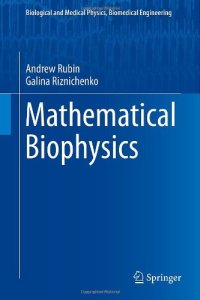
Ebook: Mathematical biophysics
- Tags: Biophysics and Biological Physics, Computer Appl. in Life Sciences, Math. Applications in Chemistry
- Series: Biological and medical physics biomedical engineering
- Year: 2014
- Publisher: Springer US
- City: New York
- Edition: 1
- Language: English
- pdf
This book presents concise descriptions and analysis of the classical and modern models used in mathematical biophysics. The authors ask the question "what new information can be provided by the models that cannot be obtained directly from experimental data?" Actively developing fields such as regulatory mechanisms in cells and subcellular systems and electron transport and energy transport in membranes are addressed together with more classical topics such as metabolic processes, nerve conduction and heart activity, chemical kinetics, population dynamics, and photosynthesis. The main approach is to describe biological processes using different mathematical approaches necessary to reveal characteristic features and properties of simulated systems. With the emergence of powerful mathematics software packages such as MAPLE, Mathematica, Mathcad, and MatLab, these methodologies are now accessible to a wide audience.
This book presents concise descriptions and analysis of the classical and modern models used in mathematical biophysics. The authors ask the question ''what new information can be provided by the models that cannot be obtained directly from experimental data?'' Actively developing fields such as regulatory mechanisms in cells and subcellular systems and electron transport and energy transport in membranes are addressed together with more classical topics such as metabolic processes, nerve conduction and heart activity, chemical kinetics, population dynamics, and photosynthesis. The main approach is to describe biological processes using different mathematical approaches necessary to reveal characteristic features and properties of simulated systems. With the emergence of powerful mathematics software packages such as MAPLE, Mathematica, Mathcad, and MatLab, these methodologies are now accessible to a wide audience.